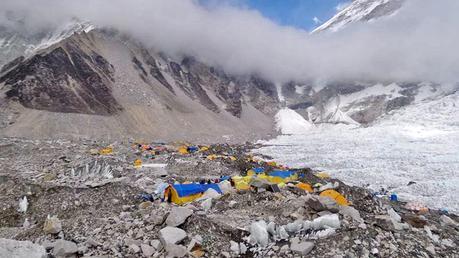 In the months leading up to the start of the spring climbing season in the Himalaya there was a lot of speculation that it would be a record-setting year throughout the region, but on Everest in particular. After two tragic and incredibly bad seasons in 2014 and 2015, last year marked a triumphant return to form in Nepal. Now, more climbers than ever are on their way to the world's highest peak, and of course that is sparking some serious concerns.
In the months leading up to the start of the spring climbing season in the Himalaya there was a lot of speculation that it would be a record-setting year throughout the region, but on Everest in particular. After two tragic and incredibly bad seasons in 2014 and 2015, last year marked a triumphant return to form in Nepal. Now, more climbers than ever are on their way to the world's highest peak, and of course that is sparking some serious concerns.According to an article in The Himalayan Times, 41 expeditions from 44 countries have applied for permits to climb Everest this year, which adds up to 376 foreign climbers on the mountain, with more expected to come. That alone doesn't sound too high when you consider about 550+ summited last season. But, as Alan Arnette points out, those are just the foreign climbers, and when you factor in the Sherpa support teams, the number actually rises to about 730 in total.
Alan also says that approximately 200 climbers will be on Lhotse this season as well, which will add to the congestion on the route up. Everest and Lhotse share much of the same route, only splitting off in opposite directions as the teams near the top. That route will be extremely crowded come mid-May, when summit bids traditionally begin. So much so, that current estimates are at about 1000 climbers in the Khumbu Icefall and climbing in the days ahead.
This will obviously cause traffic jams on the mountain. It could also lead to potential problems should the weather take an unexpected turn. That is a lot of people who will potentially be making their attempts on the summit at the same time, and since teams have often tried to get out in front of one another to avoid these problems, we could see some groups setting out early to take advantage of weather windows. Needless to say, its going to be a very interested spring on the Nepali side of the Everest.
The Times article also states that the big teams in Base Camp met this past Saturday to discuss the plan for fixing the ropes, which is traditionally handled by the larger, more experienced squads in a cooperative manner. This year, the Ministry of Tourism in Nepal has allowed helicopters to fly all of the ropes and other equipment up to Camp 2, which cuts down on the number of trips that need to be made through the Khumbu Icefall, making things safer in general.
Speaking of the Icefall, last week there was a partial collapses of the route that prevented some of the early climbers from shuttling gear up to Camp 1. It was a temporary setback however, and within a couple of days the Icefall Docs had repaired the route and things were flowing once again. But, the incident does underscore the dangers of traveling through this very treacherous section of the climb. Apparently, a large serac collapsed, taking part of the route down with it. This happens regularly throughout the season, and the Sherpa teams usually are quick and efficient about repairing it.
That's all for today. We'll have more updates soon on the current status of teams on the mountain. Most are now getting settled in BC and working on acclimation as they start their first rotations higher up the mountain. It should be interesting to see how things unfold in the days ahead.

